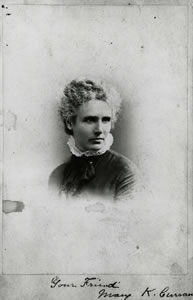Mary Katharine Brandegee facts for kids
Quick facts for kids
Mary Katharine Brandegee
|
|
|---|---|
 |
|
| Born | October 28, 1844 |
| Died | April 3, 1920 (aged 75) Berkeley, California
|
| Alma mater | University of California, San Francisco |
| Known for | studies of California flora |
| Spouse(s) |
|
| Scientific career | |
| Fields | Botany |
| Institutions | California Academy of Sciences |
| Author abbrev. (botany) | Curran, K.Brandegee |
Mary Katharine "Kate" Brandegee (born October 28, 1844 – died April 3, 1920) was an important American scientist. She was a botanist, which means she studied plants. Kate was especially known for her detailed work on the many different plants found in California.
Contents
Early Life and Family
Mary Katharine Layne was born on October 28, 1844. She was the second child of Mary Morris Layne and Marshall Layne. Her father was a farmer, and her mother was a housewife. Kate grew up in western Tennessee with her nine brothers and sisters.
Her family moved often. In 1849, they moved to California during the famous Gold Rush. Even though it was the Gold Rush, her father decided to continue farming. When Kate was nine years old, her family settled in Folsom, California.
In 1866, Kate married Hugh Curran. They were married until he passed away in 1874. Later, in 1889, she married Townshend Brandegee. They both loved science. Kate was a botanist, and Townshend was a civil engineer and plant collector. For their honeymoon, they walked all the way from San Diego to San Francisco, collecting plants!
Kate Brandegee passed away on April 3, 1920, in Berkeley, California. She was 75 years old.
Becoming a Botanist
After her first husband died, Kate moved to San Francisco. In 1875, she started medical school at the University of California at Berkeley. She was only the third woman ever to study there. During her studies, she learned about medicinal plants. This sparked her interest in botany, the study of plants.
She earned her medical degree (M.D.) in 1878. She got her license to practice medicine in California and joined the California State Medical Society. However, she decided not to become a doctor. Instead, she chose to focus on plants. In 1879, a botanist named Hans Hermann Behr became her teacher.
Work at the California Academy of Sciences
Kate Brandegee joined the California Academy of Sciences in San Francisco. She traveled all over California, collecting plants. She also worked in the Academy's herbarium. An herbarium is like a library for dried plant specimens. There, she continued her training in botany, working with another botanist, Albert Kellogg.
As she collected plants, Kate noticed something important. Many plants that scientists thought were new species were actually not truly different. She believed in evolution, the idea that species change over time. This was different from some other botanists of her time. She carefully studied plant specimens to make sure they hadn't been described before. She also checked if they were just variations of plants already known. Her detailed work helped later scientists understand where different plants grew in the Western United States.
In 1883, Albert Kellogg retired. Kate Brandegee then became the Academy's botany curator. This meant she was in charge of the plant collection. She worked hard to improve the herbarium. She also started writing and editing to create the Bulletin of the California Academy of Sciences. This bulletin helped botanists on the West Coast publish their discoveries quickly. Before this, they often had to send their findings to Asa Gray at Harvard, which took a long time. Kate's work helped scientists in California become more independent.
Later Career and Contributions
In 1890, Kate and Townshend Brandegee, along with H. W. Harkness, started a botanical journal called Zoe. This journal was a place for scientists to share articles, reviews, and even friendly criticisms of each other's work.
In 1891, Kate took a lower salary so that Alice Eastwood could join as a co-curator of the herbarium. Two years later, Kate resigned, and Alice Eastwood became the only curator. In 1894, Kate and Townshend moved to San Diego. They built their own brick herbarium and created San Diego's first botanical garden on their property. They continued to collect plants throughout California, Arizona, and Mexico.
After the big 1906 earthquake in San Francisco, the couple moved back. They gave over 76,000 plant specimens from their personal collection to the University of California, Berkeley. Even though she faced health challenges, Kate Brandegee kept collecting plants in California until she passed away in 1920.
See also
 In Spanish: Mary Katharine Brandegee para niños
In Spanish: Mary Katharine Brandegee para niños

